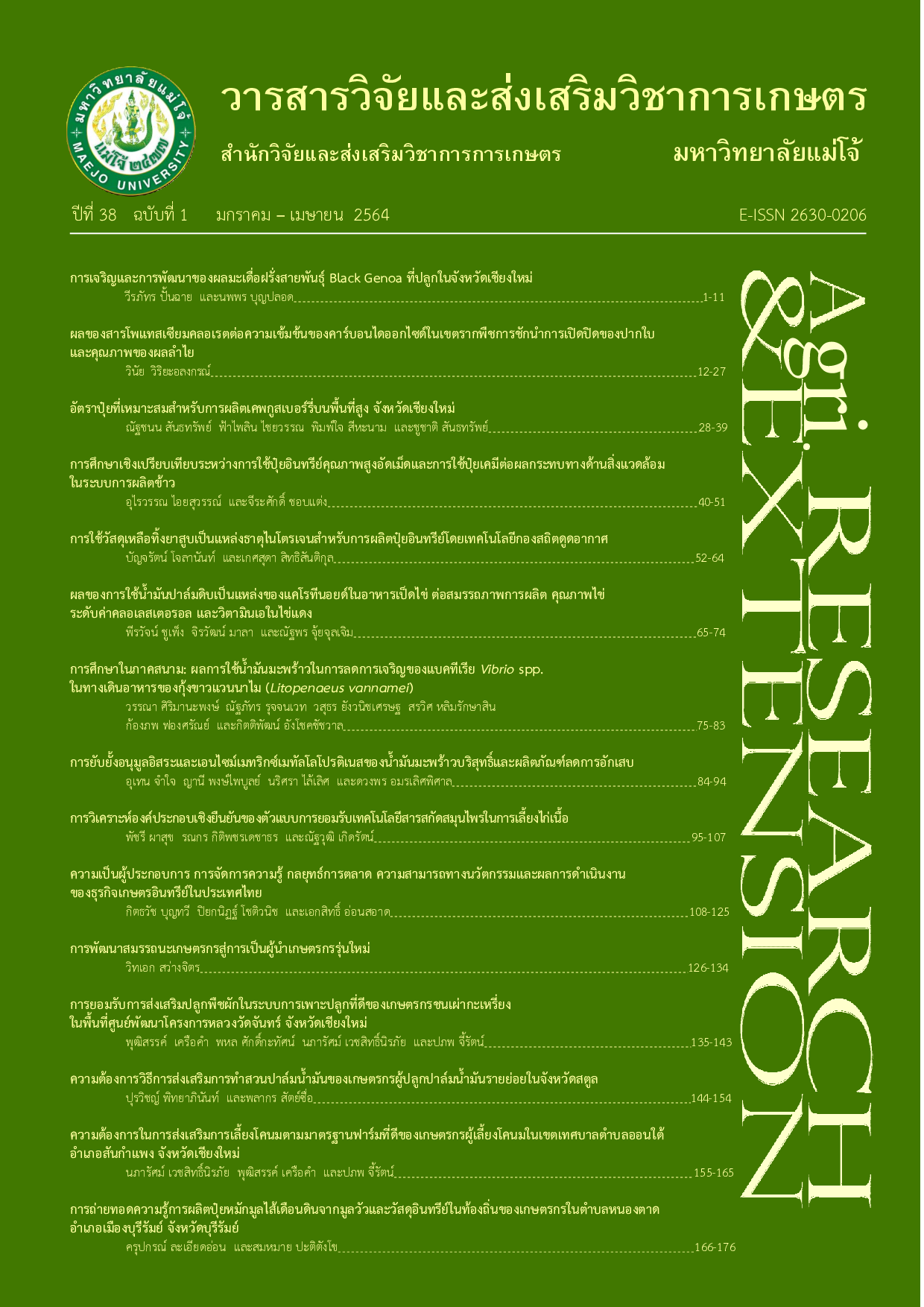อัตราปุ๋ยที่เหมาะสมสำหรับการผลิตเคพกูสเบอร์รีบนพื้นที่สูง จังหวัดเชียงใหม่
คำสำคัญ:
เคพกูสเบอร์รี, การจัดการปุ๋ย, การเจริญเติบโต, ผลผลิต, คุณภาพผลผลิตบทคัดย่อ
การศึกษาการจัดการปุ๋ยที่เหมาะสมสำหรับการผลิตเคพกูสเบอร์รีบนพื้นที่สูง ได้ดำเนินการทดลองในพื้นที่ปลูกเคพกูสเบอร์รีของเกษตรกร อำเภอเชียงดาว จังหวัดเชียงใหม่ โดยวางแผนการทดลองแบบสุ่มภายในบล็อกสมบูรณ์ จำนวน 4 ซ้ำ ประกอบไปด้วยการจัดการปุ๋ย 4 กรรมวิธี คือ 1) ใส่ปุ๋ยโดยประเมินจากปริมาณธาตุอาหารที่ติดไปกับผลผลิตของเคพกูสเบอร์รีและค่าวิเคราะห์ดินอัตราที่ 1 (70.22 กก. N/ไร่, 13.83 กก. P2O5/ไร่ และ 57.96 กก. K2O/ไร่) 2) ใส่ปุ๋ยโดยประเมินจากปริมาณธาตุอาหารที่ติดไปกับผลผลิตของเคพกูสเบอร์รีและค่าวิเคราะห์ดินอัตราที่ 2 (70.22 กก. N/ไร่) 3) ใส่ปุ๋ยตามอัตราที่นิยมปฏิบัติในการปลูกเคพกูสเบอร์รีบนพื้นที่สูง (56.00 กก. N/ไร่, 56.00 กก. P2O5/ไร่ และ 72.00 กก. K2O/ไร่) และ 4) ไม่ใส่ปุ๋ยเคมีเป็นกรรมวิธีควบคุม ผลการศึกษาพบว่าการจัดการปุ๋ยตามกรรมวิธีที่ 1, 2 และ 3 ไม่ทำให้ความสูง น้ำหนักแห้ง ธาตุอาหารหลักในใบ ปริมาณและคุณภาพผลผลิตของเคพกูสเบอร์รี แตกต่างกันอย่างมีนัยสำคัญทางสถิติ แต่อัตราการใส่ปุ๋ยโดยประเมินจากความต้องการธาตุอาหารของเคพกูสเบอร์รีและค่าวิเคราะห์ดินอัตราที่ 1 ทำให้น้ำหนักแห้ง (382.70 กรัม/ต้น) และปริมาณผลผลิต (4.66 กก./ต้น) ของเคพกูสเบอร์รีสูงที่สุด อย่างไรก็ตามการในดินที่มีฟอสฟอรัสที่เป็นประโยชน์สูง (280 มก./กก.) และโพแทสเซียมที่แลกเปลี่ยนได้สูง (262 มก./กก.) การใส่ปุ๋ยไนโตรเจนเพียงอย่างเดียวตามกรรมวิธีที่ 2 (70.22 กก. N/ไร่) เพียงพอต่อการผลิตเคพกูสเบอร์รีให้ได้ผลผลิตและคุณภาพที่ดี เคพกูสเบอร์รีให้ผลผลิตเฉลี่ย 4.41 กก./ต้น และมีเส้นผ่าศูนย์กลางผลเฉลี่ย 26.70 มม. น้ำหนักผลสดเฉลี่ย 11.25 กรัม/ผล ปริมาณกรดแอสคอร์บิก 31.94 มก./100 กรัม ปริมาณของแข็งที่ละลายน้ำได้และปริมาณกรดทั้งหมดที่ไทเทรตได้เฉลี่ย 14.33 องศาบริกซ์ และ 0.75% ตามลำดับ
เอกสารอ้างอิง
Ali, A. and B.P. Singh. 2016. Studies on production potential of cape gooseberry (Physalis peruviana L.) in sodic under varying agronomic manipulations. Journal of Applied and Natural Science 8(1): 368-374.
Association of Official Analytical Chemists. 2000. Official Methods of Analysis. 17th edition. Washington: Association of Official Analytical Chemists. 4377 p.
Conde, L.D., Z. Chen, H. Chen and H. Liao. 2014. Effects of phosphorus availability on plant growth and soil nutrient status in the rice/soybean rotation system on newly cultivated acidic soils. American Journal of Agriculture and Forestry 2(6): 309-316.
Deepti, S., A.K. Singh and K.A.P. Singh. 2018. Effects of varying doses nitrogen and phosphorus on vegetative growth, flowering and fruit quality of cape gooseberry (Physalis peruviana L.). International Journal of Current Microbiology and Applied Sciences 7(2): 126-135.
Girapu, R.K. and A. Kumar. 2006. Influence of nitrogen and spacing on growth, yield and economics of cape-gooseberry (Physalis peruviana L.) production. pp. 1425-1428. In Proceedings of the National Symposium on Production, Utilization and Export of Underutilized Fruits with Commercial Potentialities 22-24 November 2006. West Bengal: Bidhan Chandra Krishi Viswavidyalaya.
Hassan, H.A., H.M. Serag, M.S. Qadir and M.F. Ramadan. 2017. Cape gooseberry (Physalis peruviana) juice as a modulator agent for hepatocellular carcinoma-linked apoptosis and cell cycle arrest. Biomedicine & Pharmacotherapy 94(1): 1129-1137.
Highland Research and Development Institute (HRDI). 2016. Cape gooseberry handbook. [Online]. Available https://hkm.hrdi.or.th/media/detail/238/5 (27 April 2020).
Horneck, D.A., D.M. Sullivan, J.S. Owen and J.M. Hart. 2011. Soil Test Interpretation Guide. [Online]. Available https://www.extension.oregonstate.edulcatalog/ (15 October 2019).
International Fertilizer Association. 2016. Nutrient Management Handbook. [Online]. Available https://www.fertilizer.org/Nutrient_ManagementHandbook.pdf (3 November 2019).
Kalra, Y.P. 1998. Handbook of Reference Methods for Plant Analysis. Boca Raton: CRC Press. 300 p.
Li, H., G. Huang, Q. Meng, L. Ma, L. Yuan, F. Wang, W. Zhang, Z. Cui, J. Shen, X. Chen, R. Jiang and F. Zhang. 2011. Integrated soil and plant phosphorus management for crop and environment in china. Plant Soil 349: 157-167.
Lorensini, F., C.A. Ceretta, C.R. Lourenzi, L.D. Conti, T.L. Tiecher, G.T. Trentin and G. Brunetto. 2015. Nitrogen fertilizer of cabernet sauvignon grapevines: yield, total nitrogen content in the leaves and must composition. Acta Scientiarum Agronomy 37(3): 321-329.
Nemr, M.A.E., M.M.H. Baky, S.R. Salman and W.A.E. Tohamy. 2012. Effect of different potassium levels on the growth, yield and quality of tomato grown in sand-ponic culture. Australian Journal of Basic Applied Sciences 6(2): 779-784.
Novozamsky, I., R.V. Eck, J.Ch.V. Schouwenburg and I. Wallinga. 1974. Total nitrogen determination in plant material by means of the indophenol blue method. Netherlands Journal of Agriculture Science 22: 3-5.
Olivar, V.T., A.R. Martinez, M.A.R. maria and L.A.V. aguilar. 2014. Role of nitrogen and nutrients in crop production. Journal of Agricultural Science and Technology 4: 29-37.
Prajapati, K. and H.A. Modi. 2012. The importance of potassium in plant growth. Indian Journal of Plant Sciences 1(2): 177-180.
Prakash, O., A. Kumar and Y. Singh. 2017. Effect of nitrogen, zinc sulfate and boron on growth and yield of cape gooseberry (Physalis peruviana L.). International of Pure & Applied Bioscience 5(3): 74-84.
Ranganna, S. 1986. Handbook of Analysis and Quality Control for Fruit and Vegetable Products. 2nd edition. New Delhi: Tata Mc Graw-Hill Publishing. 1112 p.
Roy, R.N., A. Finck, G.J. Blair and H.L.S. Tandon. 2006. Plant Nutrition for Food Security. Rome: FAO. 347 p.
Santasup, C., F. Chaiwon and K. Ueangsawat. 2018. Improvement of water-saving and fertilizer use efficiency for fruit orchard in highland area. 111 p. In Research Report. Chiang Mai: Highland Research and Development Institute (Public Organization). [in Thai]
Tohamy, W.A.E., S. Abouhussein and N. Gruda. 2009. Response of Cape gooseberry (Physalis peruviana L.) to nitrogen application under sandy soil conditions. Gesunde Pflanzen 61: 123-127.
Torres, J., N.P. Seva. A.S. Bautista, B. Pascual, S.L. Galarza, J. Alagarda and J.V. Maroto. 2014. Growth and nutrient absorption of cape gooseberry (Physalis peruviana L.) in soilless culture. Journal of Plant Nutrition 38(4): 485-496.
Walinga, I., J.J. van der Lee, V.J.G. Houba, W. van Vark and I. Novozamsky. 1995. Plant Analysis Manual. Dordrecht: Springer. 275 p.
Woldemariam, S.H., D. Zeru and M.T. Solomon. 2018. Effects of potassium levels on productivity and fruit quality of tomato (Lycopersicon esculentum L.). Journal of Agricultural Studies 6(1): 104-117.
Zhu, Q. and M.O. Hampton. 2017. Effect of phosphorus rates on growth, yield, and phosharvest quality of tomato in calcareous soil. HortScience 52(10): 1406-1412.
ดาวน์โหลด
เผยแพร่แล้ว
รูปแบบการอ้างอิง
ฉบับ
ประเภทบทความ
สัญญาอนุญาต
บทความนี้ได้รับการเผยแพร่ภายใต้สัญญาอนุญาต Creative Commons Attribution-NonCommercial-NoDerivatives 4.0 International (CC BY-NC-ND 4.0) ซึ่งอนุญาตให้ผู้อื่นสามารถแชร์บทความได้โดยให้เครดิตผู้เขียนและห้ามนำไปใช้เพื่อการค้าหรือดัดแปลง หากต้องการใช้งานซ้ำในลักษณะอื่น ๆ หรือการเผยแพร่ซ้ำ จำเป็นต้องได้รับอนุญาตจากวารสาร





